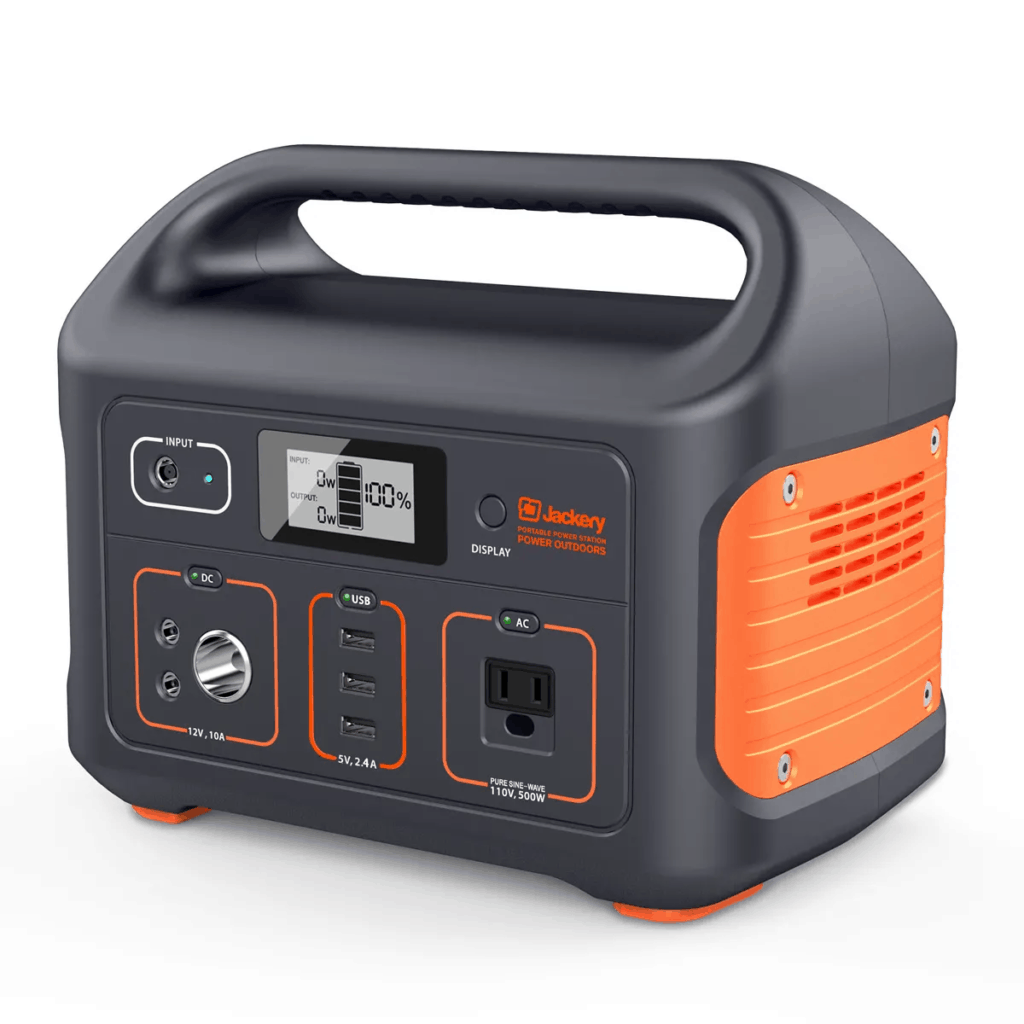
Jackery Portable Power Station: Product Review
A modern RV can be like a portable power station. Generators, solar setups, and modern lithium-ion battery banks are all devices that RVers can use to power their electronics and appliances. Many full-time boondockers have nice solar kits installed on their rigs with battery banks that give them all the power they need off-the-grid.
Solar systems with that kind of power are awesome and perfectly suited for those that depend on and camp in their RV for weeks or months at a time. The weekend warrior type may not see the point of having a several thousand dollar solar setup that sits in storage when they aren’t camping.
I not only write about RVing, but my wife and I have lived and traveled in an RV for six years. We spend a lot of our time in RV parks and boondock while traveling. Our motorhome has an onboard generator capable of running everything we need and an inverter that allows us to run our laptops, TV, and other small appliances off the batteries. Since we stay in parks a lot, we have never thought about adding another means of using power separate from the power system in our RV.
This is until we were given the chance to test out Jackery’s Explorer 1000 portable power station with the two optional 100W solar panels. The advantages and freedom the portable power station has given us in just a short time make us wonder how we ever traveled without one in the first place.
What is a portable power station?
Just like the name suggests, portable power stations are devices that can be easily moved and provide power when needed. Most have a lithium-ion battery to store and provide DC power to charge USB devices like phones, tablets, lights, and other small rechargeable devices.
They have an inverter built-in to convert the DC power into AC to run 110-120 volt appliances. After the battery is used up, it must be recharged. There are many ways to recharge a portable power station. Solar, AC plug, and 12-volt car ports are the most common.
What are the advantages of a portable power station?
For an RVer, it is possible to get an inverter installed on your RV to get 120V AC power from your house batteries. One advantage a portable power station has is its portability.
When camping, people don’t always stay in their RV. A portable power station can be placed outside to run stereos, cooking appliances, fans, projectors, and many other things without the noise of a generator.
There are many other uses like having backup watts of power available, emergency power for your home or car, and portable power for projects outside the home or anywhere.
As mentioned above, I had the opportunity to put the Jackery Explorer 1000 and two of the 100w solar panels on a test run. So let’s see what the Explorer 1000, Jackery’s largest and most powerful power station in the Explorer series, has under the hood.
Jackery Explorer 1000 Portable Power Station Specs
Look and feel of the Explorer 1000
Overall, the Explorer 1000 has a very streamline, solid look and feel. For the power it puts out, it is was pretty light, 22 lbs, according to their website. In comparison, that is a little lighter than a gas-powered 1000-watt inverter generator. It is small enough to fit on the floor of a truck or car, or just about anywhere inside a motorhome.
The bright LED light on the side of the unit is a nice addition. I used it on a couple of occasions to light up a picnic table at our campsite while I used the power station to cook dinner on an electric range. It also has an SOS feature that blinks in the three-short, three-long, three-short SOS pattern in case of an emergency.
The LCD display is easy to read and displays a graphic of how charged the battery is as well as the current charge in percentage. It displays the watts (power) going into the power station and going out. This is a nifty feature since it has passthrough charging—the ability to be used while charging.

SolarSaga 100W Solar Panel
The first word that came to mind when I was pulling each solar panel out of the packaging was “compact.” The SolarSaga 100W Solar Panel is designed for portability. Though the panel is light, a little over 9 lbs, it looks durable. Each panel has two USB ports, so it is possible to charge a phone or tablet directly from the panel.
The SolarSaga has several grommets that allow it to be hung on a wall for storage. It folds in half for easy transport and has a durable TPE rubber handle with magnets to hold the panel closed while stored.
It has semi-ridged kickstands to angle it toward the sun. They are velcroed onto one side to hold them flat during transport and have a strap that prevents them from being opened too far. The back of the panels also have a zipper pouch that houses the cord used to plug into a Jackery portable power station, or the included SolarSaga Parallel Adapter to charge with two panels at once.
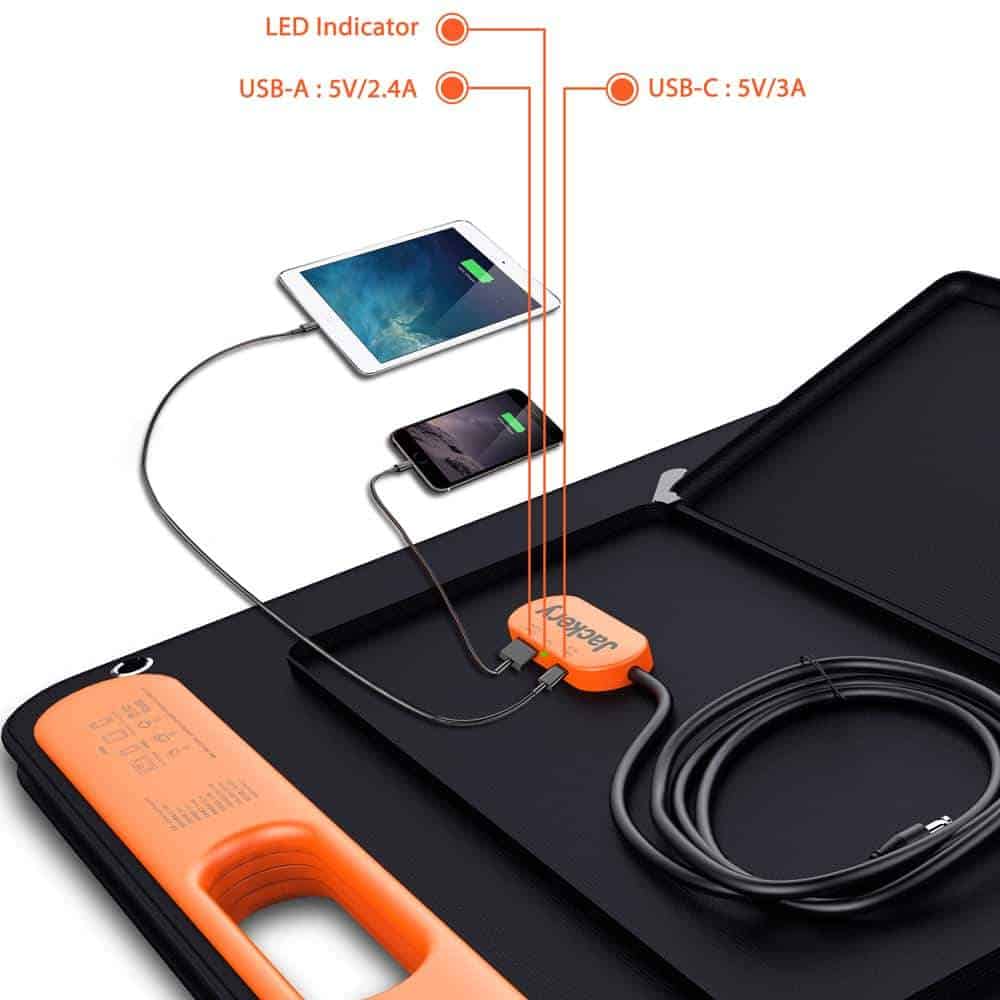
Let’s take it apart
I’m not really going to take it apart. It’s new, and my wife won’t let me. But that won’t stop us from finding out what makes it tick.
Explorer 1000 Portable Power Station
Battery
The Jackery comes with a lithium nickel manganese cobalt oxide battery. This type of battery is known for its high energy density. In other words, they pack a lot of power in a small space and can be found in most electric cars and large battery storage power stations.
For safety, Jackery power stations have a BMS or battery management system, over-voltage protection, and short circuit protection. NMC lithium-ion batteries are also known to have a long life overall.
Pure Sine Wave Inverter
All batteries give DC or direct current. The lithium battery is where the power station gets its DC. DC current powers the USB ports and the 12-volt power port of the Explorer 1000.
To run AC devices like fans, TVs, and laptop chargers, you have to convert the battery’s DC current into AC or alternating current. To do that, an inverter must be used. You are probably familiar with an inverter and may have used one in the past, but inverters come in different types.
First, it’s important to have an idea of how AC and DC power differs. Batteries work by creating a chemical reaction that ultimately causes electrons to flow through a conductor in a circuit. The electricity in a battery always flows directly from the negative terminal to the positive terminal and only in that direction. That is why it is called a direct current.
AC sloshes back and forth, so to speak. In this animation below, you can get an idea of how AC current flows through a line.
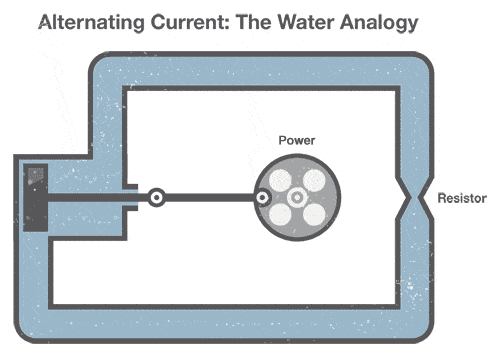

There is an easy way to get that alternating current from direct current, and it produces the equivalent of a cheap imitation. Most inverters today create what is known as a modified sine wave.
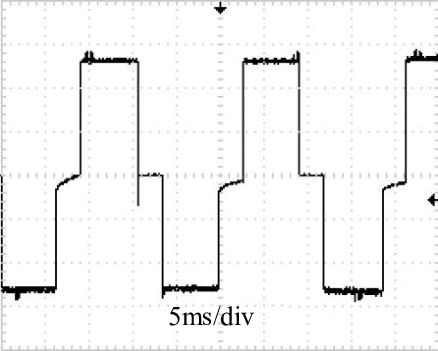
A modified sine wave works great for basic electronics like lights. Most devices like phone chargers, laptop chargers, and many TVs have their own filters built-in or change the AC back to DC. This allows them to work well enough on a modified sine wave.
The disadvantage of a modified sine wave is that appliances will run less efficiently. If you plug a fan, residential refrigerator, or any other device that has a motor into a modified sine wave inverter, they will work but not efficiently. They may buzz or sound louder than usual. They will generate excess heat, and for some components, it will greatly shorten the lifespan. Some sensitive digital electronics may not work at all. For example, many CPAP machines will not function properly using a modified sine wave.
A pure sine wave inverter mimics the smooth sine wave of AC perfectly. So motors, sensitive medical equipment, and all other electronics will function just like they would if you plugged them into a wall outlet. They will not generate excess heat, and the lifespan of the equipment will not be affected.
The reason modified sine wave inverters are used in some portable power supply products is because it takes fewer components to generate the modified sine wave. Fewer parts mean the product can be sold at a cheaper price. But like all things, you get what you pay for.
Jackery’s power station products, including the Explorer 1000, have a pure sine wave inverter. This is especially nice because I did not have to worry about what I was plugging into it. For RVers who use a CPAP machine, it can be a great backup power source for your machine or a regular power source for it if you are boondocking.
My experience with the portable power station
I took the Jackery Explorer 1000 on a two-week boondocking trip. As mentioned above, I have a generator and 1000-watt modified sine wave inverter on my motorhome. My goal was to not only test the Explorer 1000 but determine if it actually made my RV experience better.
Charging
The Explorer 1000 has three means to charge the battery. When I first got the portable power station, I used the wall outlet charger to charge it.
120V Charging
Charging with a 120V outlet is by far the fastest charging method for any portable power station. I charged my power station with my generator whenever it was on. There is no sense letting all the generator power go to waste when I can store some of it for later.
I calculated that from a full discharge, it would take about 6.25 hours to charge. That is in line with their site, which says that it can take about 7 hours to charge by AC.
Solar charging
Using the two solar panels varies greatly as far as charge times. On a cloudy day, it will take longer to charge. In optimal conditions, on a clear day, the two SolarSaga 100W panels met my expectations.
According to Jackery’s site, the solar panels will charge the Explorer 1000 in 8 hours. When I checked the charging rate closely, I determined that on a clear day with lots of sunlight, the panels would charge the Explorer 1000 in about 8.3 hours.
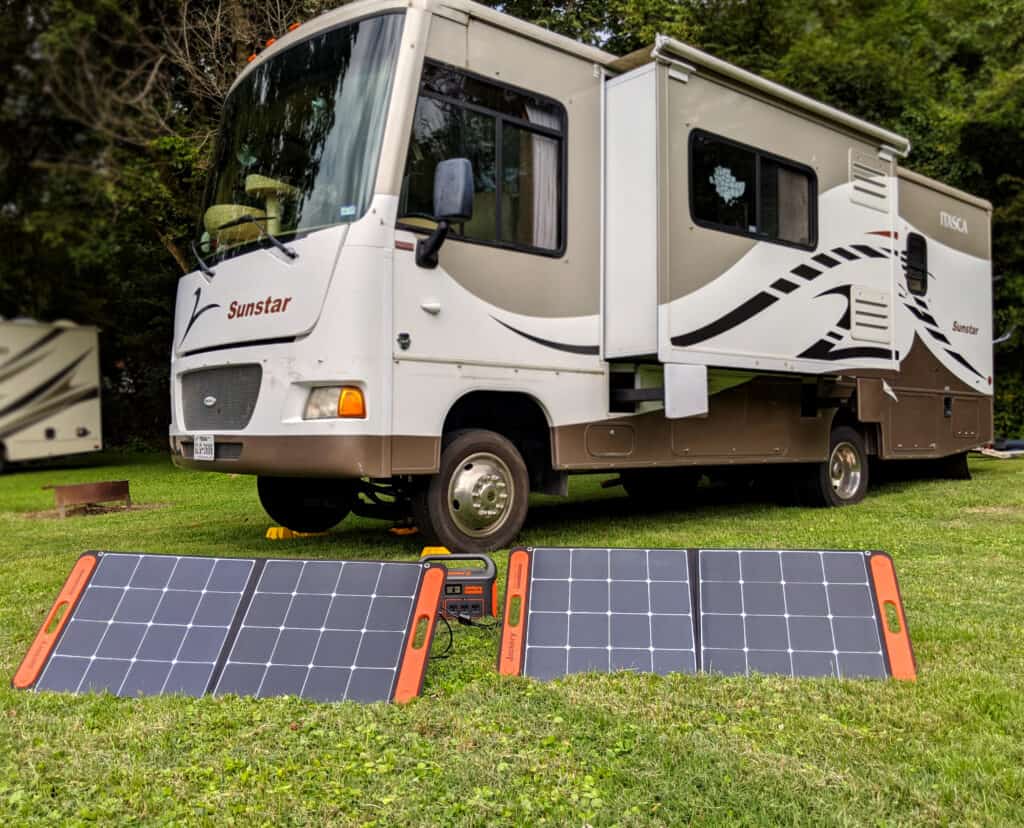
The panels were lightweight and easy to set up. I would say the only drawback to these panels is they are not meant to get wet. It’s not like you are going to get much charging done on a rainy day, but at one point during my camping trip, a quick storm blew in, and I had to quickly get everything picked up before the rain started.
12V Car Port
The slowest charging method by far is the 12V charger that comes with the Explorer 1000. According to Jackery, it takes 14 hours to charge the power station with a car adapter, and my calculations were around 14-17 hours, depending on if I was charging from the alternator with the engine running or if I was pulling directly off the battery with the engine off.
Keeping the Explorer 1000 charged
I found that using a combination of charging methods allowed me to use the portable power station and keep it charged throughout the day. Before I had the power station, I had to keep my house batteries charged to use the inverter for my day to day needs. This required my generator to run about 6 hours a day if I didn’t need the AC.
With the Explorer 1000, I only had to run the generator for about 3 hours a day. I set up the solar panels in the morning and used my house batteries during the day. As evening came, I would run my generator to charge my house batteries and plugged the Jackery into the 120V wall outlet to finish off the charge.
While traveling in the RV, I used the 12V car port to charge the power station. If we were running the generator while driving, we would use the 120V charging method. Using the above method, we were able to keep the Jackery Explorer 1000 charged and ready to use throughout 10 days of boondocking.
How we used it
Cooling
We were camping in August and September, so the temperature was not exactly cold. Along with charging our phones, we were able to run our 120V fan off the Explorer 1000. This served two purposes. The first was to keep air circulating, so the RV stayed cool as long as possible, and the second was to remove that power drain from our house batteries. By using the Jackery to run our 45W fan, we could save our house batteries for powering our laptops, TV, lights, and fridge.
On a good day, the solar panels would be inputting about 120 watts or more. That meant that I could plug in my 45-watt fan into the Explorer 1000 and run it directly off the solar panels. Since the input wattage was more than the output, the battery was still charging. In essence, my portable power station had become a solar generator.
Splitting the Watts
In the RV world, extra watts are always welcome. If you are limited to 30 amps or 3600 watts, you can trip a breaker with just a coffee maker and an air conditioner running at once. Many people use smaller generators to save weight. These generators typically only supply up to 2000 watts. Regardless of the size of your generator, it has to work relatively hard to run any appliances in addition to your air conditioner.
The Explorer 1000 gave me an additional 1000 watts to play with. I used it to take the strain off my generator by making coffee with the power station while my generator was running my air conditioner. I can run the two easily from my generator now that I have a SoftStartRV installed, but I figure if I have the spare amps, why make the generator work?
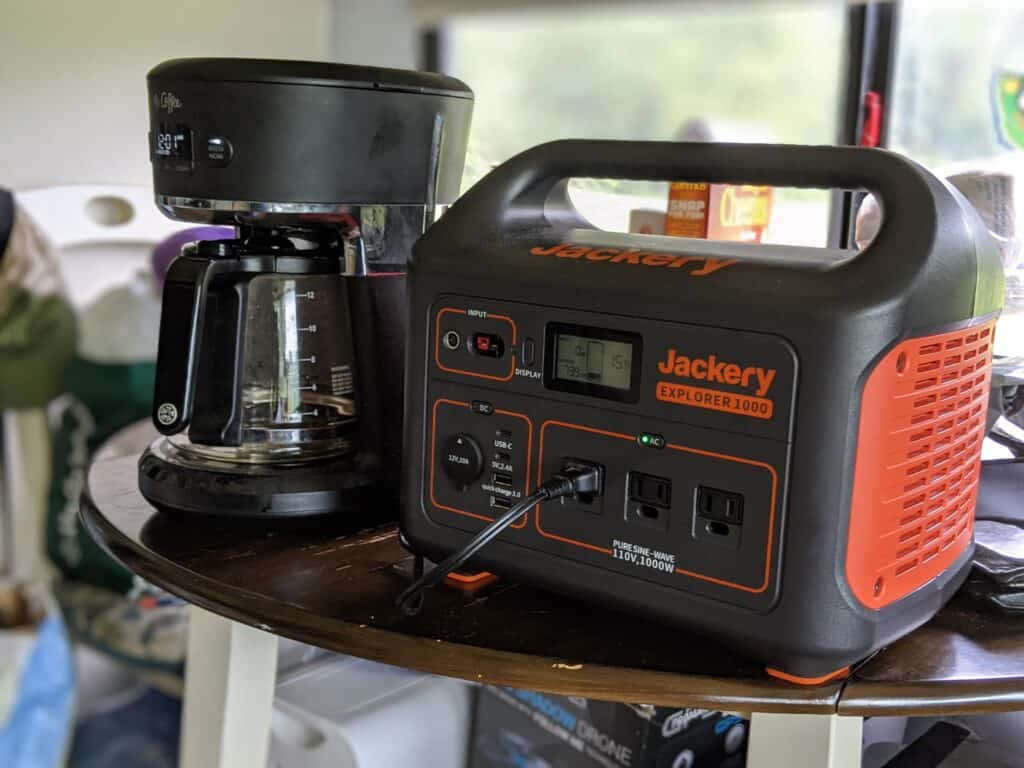
Cooking and outside power
Cooking outside is one great aspect of boondocking or wilderness camping. I don’t always want to start a fire, and grilling everything gets old. Sometimes I want cooked spinach and eggs in the morning or sauteed onions for my burger. I was able to use the Jackery to power my portable hotplate cooktop and cook squash and mushrooms from a picnic table. Doing the same task with my RV’s inverter or generator would require a long cord.
My cooktop takes about 750 watts to run, which means the battery was drained pretty quick. Don’t plan on slow-cooking a pot of award-winning chili. I found that as long as there is a decent charge of above 75%, I could cook a quick meal or side dish.
It was nice being able to take the power wherever I needed it. We always had a nearby place to plug our laptops, cooktop, or other electronic devices without having to run extension cords from our RV. At around 20lbs, the Explorer 1000 is not ideal to bring on a long hike, but it is portable enough to be taken wherever you need the power.
Conclusion
I have found the Jackery Explorer 1000 and the two SolarSaga 100W panels to be great for RVers. I have found ways that the portable power station can be used almost every day. I am writing this sitting outside my RV with my laptop plugged into the Explorer 1000.
It is possible to have a solar system installed on your RV to keep your house batteries charged. I like the idea that I have a separate power system from my RV that I can take wherever I go. So even when I upgrade to a solar system for my rig, I still think a Jackery portable power station would be useful, and now that I have used it, it is a necessary piece of equipment for my RV life.
Full-time RVers will benefit from having the extra watts and portability, especially when boondocking. Weekend warriors will most likely enjoy the idea that the power station is not stuck in storage when they aren’t camping. The product can be used to power things in backyards, during sports games, at picnics, and while enjoying any other non-RV activities.
RVers will benefit from having a portable means of backup power when their power stops working. For product performance, portability, and usefulness, I would definitely recommend a Jackery portable power station.
Watch the video
Get 15% off for their 9th Anniversary
If you’re looking for your own portable power, now is the best time to buy! In honor of their 9th Anniversary, Jackery is currently offering 15% all of their product lines on their website from October 18-20. To learn more, visit their website at Jackery.com.
If you are looking for more reasons a portable power station can be a useful addition to your RV power needs, check out 9 Reasons Every RV Owner Needs A Portable Power Station.


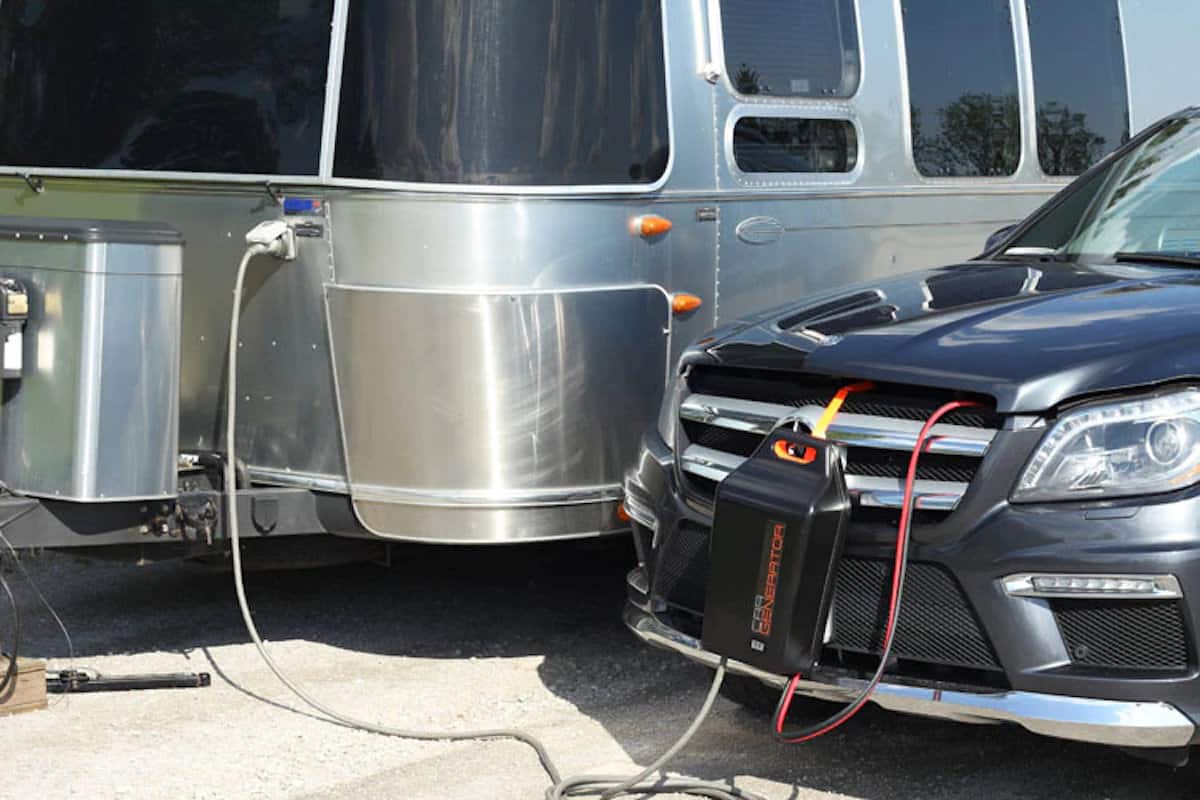

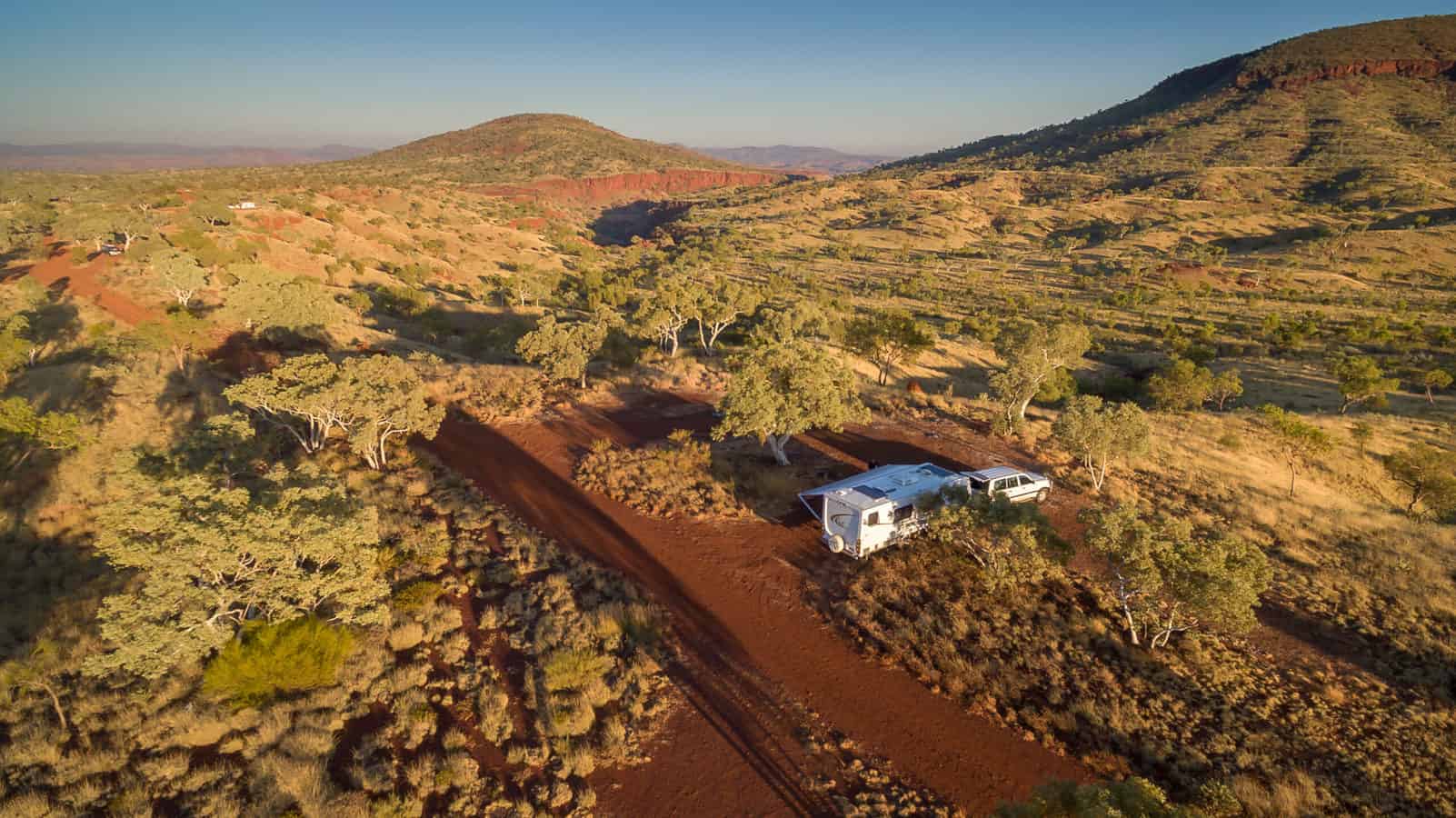
This is interesting as I cannot carry a lot of weight and need to move away from even 50lb generators. If I want this as a backup to keep the 12V (pulling 5-8AMPs) refrigerator working but cannot directly plug the refrigerator in:
1. Can we plug this in to the shore power cord with the adapter?
2. Wire directly to my battery bank ?
3. In terms of amp hours, how many does this basically store?
4. What on the solar panel is not waterproof, the entire panel or the controllers and connections underneath?
5. What are the storage conditions for this lithium battery? lowest to highest temps/rain/misting etc.
Nice. If you want to spend the $ on it. I have the $, but not going to get one. My rig, when finished, will be simple, and done by me. It is a Dodge 3500 van, extended wheelbase, high top. I will have a battery bank, but it will be charged by a combination of solar panels, DIY gas generator (with a very quiet exhaust system), and a wind powered generator. Been doing my homework for a lonnng time. My rig will not be for a whole lot of people, but it will certainly be right for me. Nothing propane, period. And what little electric needs I will have will be easily handled by my setup. Like I said, it will be great for me, but not for a lot of other people. To each his own.
sounds amazing – best of luck with you build
OK can I plug my 30 amp power cord in my RV to the Jacquerie battery to start a heater?
Yes. I had my jackery 1000 hooked up to my MOHO with an adapter and was running a 43 inch TV and direct tv receiver and speakers. If you have a small heater it would work fine.
With a 30A->20A adapter you sure can.